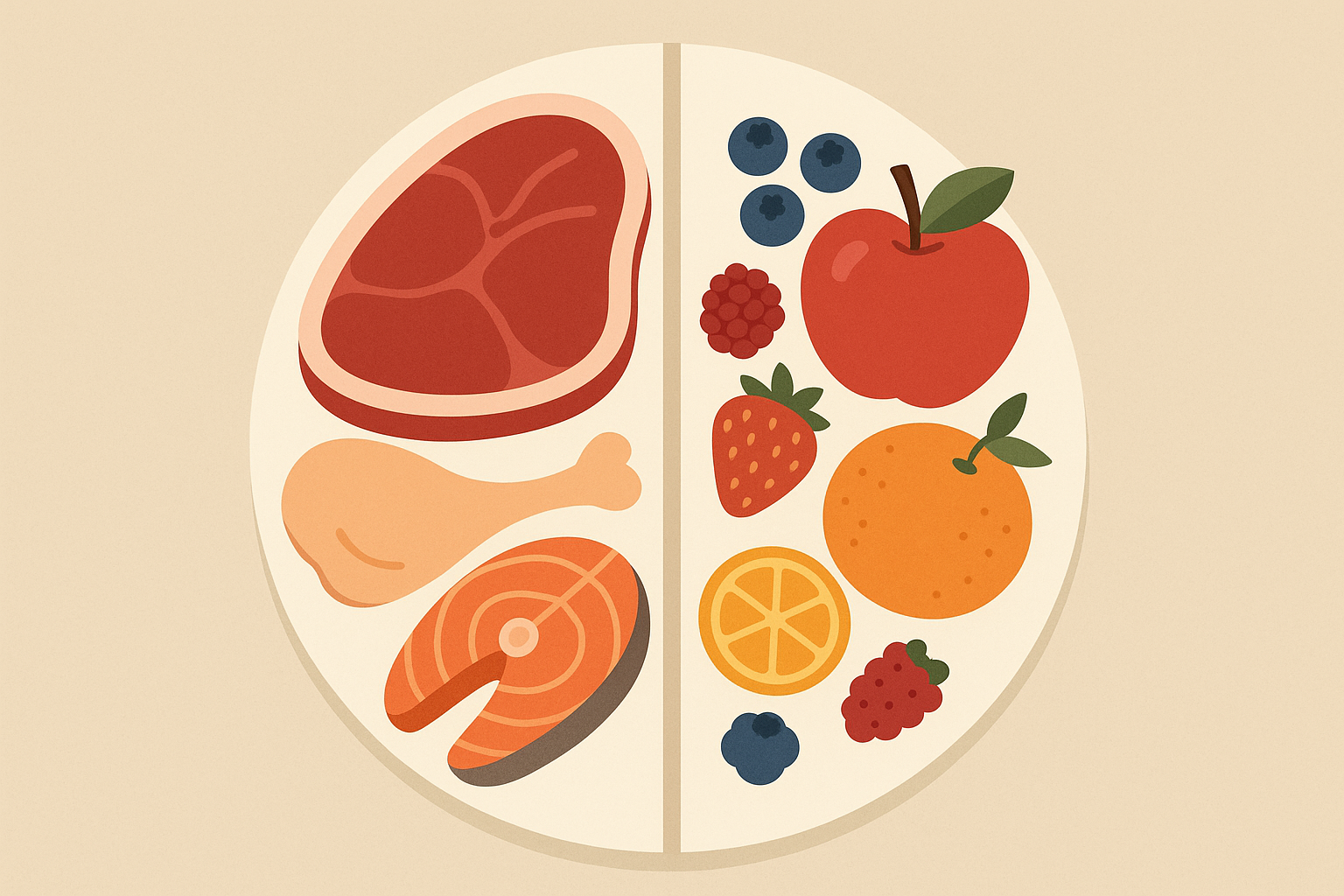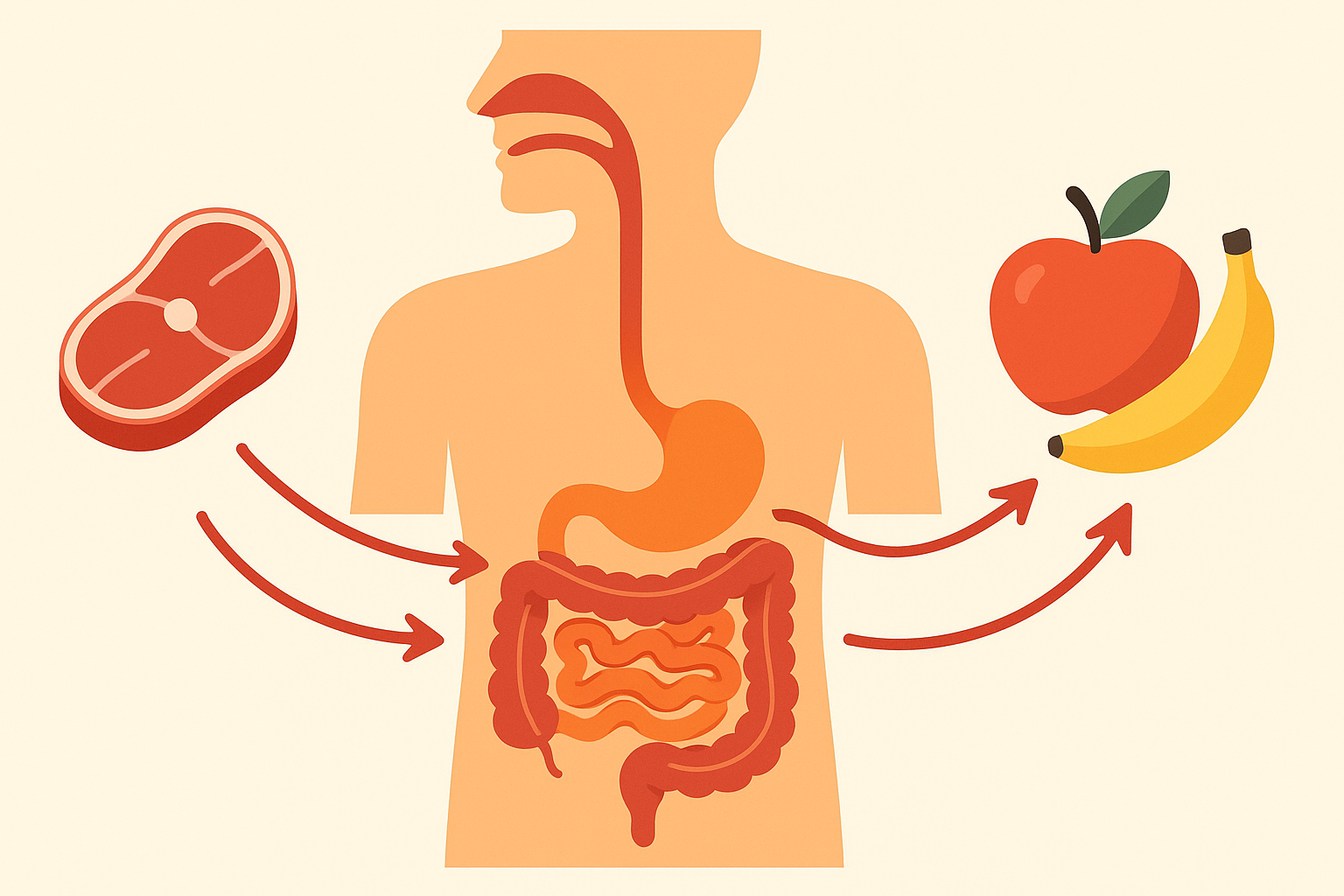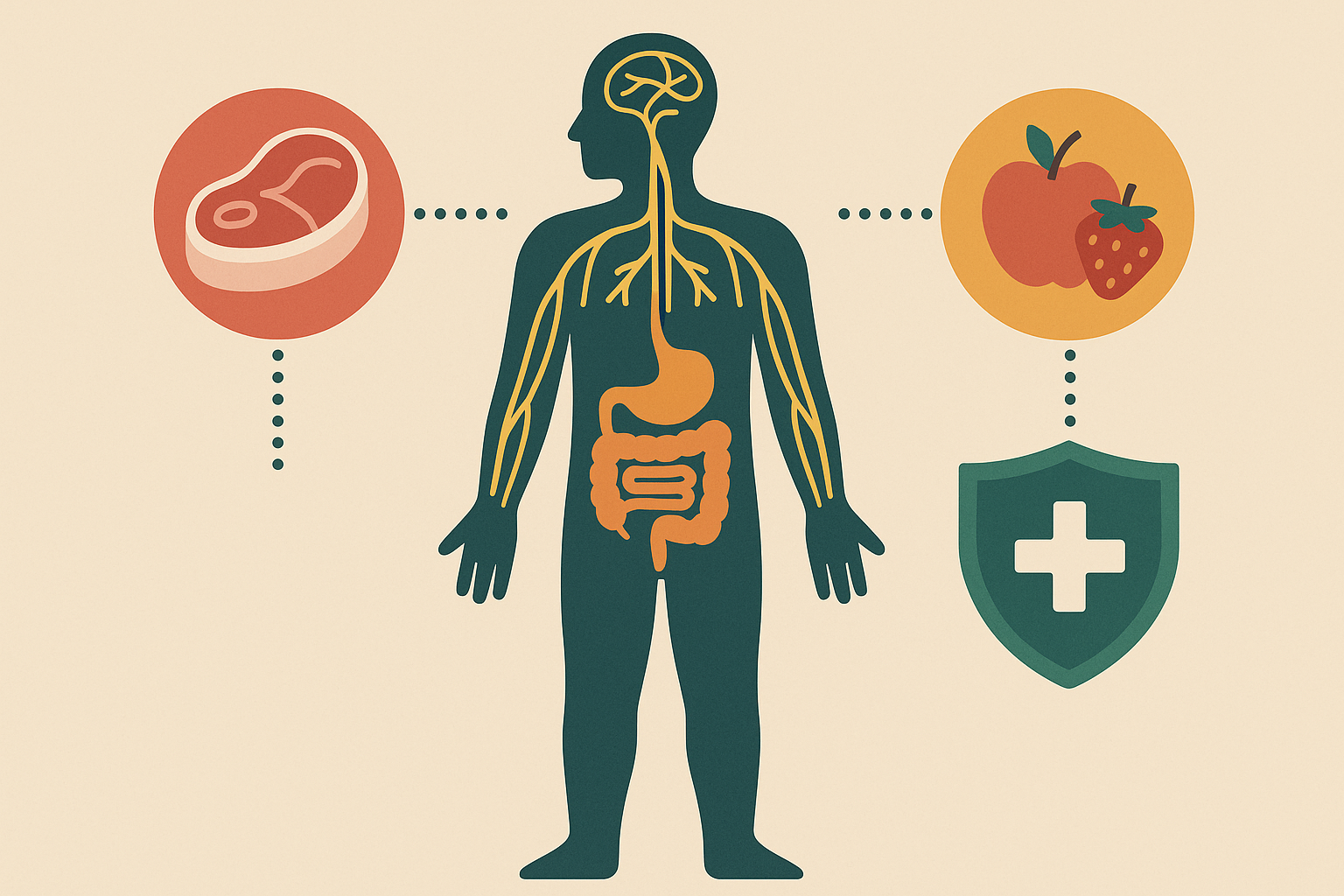Meat and Fruit Diet Meal Plan: Why I Ditched Complex Nutrition for This Simple Two-Food System


Look, I’m not a nutritionist or anything, but after years of trying every diet under the sun, I stumbled onto something that actually worked for me. I spent way too much time obsessing over complicated meal plans, counting macros like it was my job, and following whatever nutrition trend was popular that week. Then I discovered something ridiculously simple – just eating meat and fruit.
I know this sounds weird, but hear me out. This isn’t some crazy fad I read about on social media. The meat and fruit approach is actually gaining momentum among regular people who got tired of complicated rules. Recent data shows that people following this approach eat between 1 to 2.5 lbs of meat per day, with fruit intake varying dramatically from less than 50 grams of daily carbs to maintain ketosis, while others consume up to 300 grams of carbs daily from sugary fruits according to Doctor Kiltz. That flexibility is what makes it actually doable for real people with real lives.
Table of Contents
- The Science Behind My Metabolic Reset Journey
- Building Your Personal Implementation Strategy
- Advanced Applications for Specific Health Goals
- Making It Work in Real Life (Without Going Crazy)
TL;DR
- Eating meat and fruit together just makes sense – your body actually uses the nutrients instead of fighting to process weird food combinations
- There’s no one-size-fits-all version of this, which is why it actually works long-term
- Timing when you eat these foods can completely change how you feel throughout the day
- This helped with issues I didn’t even realize were connected to what I was eating
- You’ll need to adjust things as you go, but that’s way easier than following some rigid meal plan forever
The Science Behind My Metabolic Reset Journey
Here’s the thing that surprised me – understanding how meat and fruit work together completely changed how I felt every single day. This isn’t about following another restrictive diet that makes you miserable. It’s about finally working with your body instead of against it.
I’ll be honest, I used to think my constant energy crashes and digestive issues were just normal parts of getting older. Turns out I was just making my body work way harder than it needed to by eating foods that don’t play well together. When I started paying attention to how different meals affected me, I realized I’d been fighting my own digestive system for years.
Understanding the fundamentals of intermittent fasting actually helped me figure out better timing for this approach. I found that combining these principles with strategic meal planning created effects I hadn’t experienced with either approach alone.
The carnivore diet meal plan foundation becomes way more sustainable when you understand why certain food combinations just work. I’ve seen people struggle with strict carnivore approaches because they’re missing key nutrients that fruits naturally provide. Even the hardcore carnivore community has started recognizing this, which is why many long-term practitioners sneak in some strategic fruit.
How Food Pairing Actually Makes You Feel Better
Look, I’m going to try to explain this without getting too nerdy. When you eat animal proteins and natural fruit sugars together, your body can actually use the nutrients you’re giving it. Most people eat foods that basically compete with each other for absorption, but meat and fruit are like best friends – they help each other out.
This means you get more bang for your buck from what you eat, which explains why I started feeling satisfied with less food. I noticed this within the first week – I was eating smaller portions but had energy that lasted for hours instead of crashing after every meal.
The carnivore diet principles make more sense when you understand these partnerships. I used to think eating just meat would give me everything I needed, but I was missing crucial pieces that help your body actually use those nutrients. Adding strategic fruits to my approach completely changed how I felt and performed.
Why Your Body Actually Craves This Combination
Animal proteins give your body the building blocks it needs – think of them as raw materials. Fruit provides vitamin C, which acts like the foreman telling your body how to use those materials properly. This creates way better results than taking random supplements because your body recognizes these nutrients as they naturally occur together.
I’ve noticed my skin looks better and my joints don’t ache like they used to when I keep this combination consistent. My recovery from workouts improved dramatically once I figured out this connection.
Research shows that fresh beef provides approximately 1.6 mcg/g of vitamin C in grain-fed meat and 2.56 mcg/g in grass-fed meat, with consumers eating 1000 grams of meat (2.2 lbs) per day getting between 16 mcg and 25.6 mcg of vitamin C according to Doctor Kiltz – way more than I expected, and enough to prevent deficiency while supporting my body’s repair processes.
The carnivore approach provides more vitamin C than I realized, but adding fruits creates the perfect environment for my body to actually build and repair itself properly. I’ve experienced this firsthand through better skin quality and faster healing from minor injuries.
The Energy Game-Changer I Wish I’d Known Sooner
Here’s something that blew my mind – the iron from meat combined with natural acids from fruits creates these partnerships that help your body actually absorb minerals like iron, zinc, and copper. This is why my energy levels went through the roof – I was finally absorbing the minerals I’d been eating but not using.
The difference in my energy became noticeable within the first few weeks. I’d been taking iron supplements for years with zero results, but this natural combination solved my absorption issues completely.
The carnivore diet provides tons of minerals, but without the right helpers, your body struggles to use them. This approach, enhanced with strategic fruit, optimizes mineral absorption in ways that expensive supplements never could for me.
Timing That Actually Works With Your Body
Your digestive system has a natural rhythm – it starts with protein digestion in an acidic environment, then transitions to processing fruit sugars in a more alkaline state. When you time these foods right, you’re working with your body’s natural flow instead of forcing it to constantly switch gears.
This eliminated the bloating and digestive discomfort I used to get after meals. I used to feel stuffed and sluggish after eating, but proper timing fixed these issues completely.
A practical example that works for me: I’ll start with 6-8 oz of grilled salmon, let my body work on that for 20-30 minutes, then finish with a cup of berries. This sequence feels natural and keeps my energy steady for hours.
Those dealing with digestive issues might benefit from understanding simple ways to beat bloat and improve digestion alongside implementing proper meal timing. Combining these strategies with my approach created the perfect conditions for comfortable digestion.
The carnivore diet becomes way more comfortable when you understand this timing. I’ve helped several friends transition to carnivore eating by teaching them these principles, which prevents the digestive overwhelm that makes most people quit.
How This Approach Reset My Hormones
I’m not going to pretend I understand all the technical stuff about hormones, but I can tell you what happened to me. The combination of quality animal proteins with natural fruit sugars seemed to give my body the right signals at the right times to get my hormones back on track.
Within the first month, I was sleeping better, my energy was steady throughout the day, and my mood stopped being all over the place. My stress levels became much more manageable, and my doctor said my thyroid function improved significantly.
The carnivore lifestyle supports hormone health through nutrient density, but strategic fruit addition provides the glucose my thyroid apparently needed. Many people following strict carnivore approaches experience thyroid issues, which this combination prevents.
Blood Sugar That Actually Stays Stable
Here’s something that surprised me – timing fruit around my meat meals actually improved my blood sugar control. Instead of avoiding all sugars, strategic timing of natural sugars around protein meals helped my body handle glucose better.
My glucose tolerance improved significantly using this approach, even while including fruits I previously avoided. My HbA1c dropped from 5.8 to 5.2 over six months, which shocked both me and my doctor.
This aligns with what podcaster Joe Rogan announced in January 2022 on Instagram that he has since added fruit to his all-meat diet according to Hone Health, citing improved workout performance and recovery when strategically timing carbohydrates around training sessions.
The carnivore diet meal plan becomes more sustainable when you understand blood sugar optimization. I’ve maintained excellent blood sugar control while enjoying fruits that I thought were completely off-limits.
Getting More From Less Food
The relationship between nutrients from meat and natural compounds from fruits creates a nutritional profile that’s way more effective than eating these foods separately. This explains why I started feeling better in multiple ways at once rather than just targeting one specific issue.
I stopped taking most of my supplements within three months because my nutrient status improved across the board. My doctor was amazed at the changes in my lab work and kept asking what I was doing differently.
The carnivore approach provides incredible nutrient density, but certain vitamins and minerals need helpers to work properly. The carnivore community has figured this out, which is why many experienced practitioners incorporate strategic plant foods. The carnivore diet works even better when you understand these partnerships.
Here’s what I noticed when I started paying attention to how foods worked together:
- When I ate steak with some berries, I felt amazing for hours
- Iron supplements never worked for me, but somehow I stopped being tired all the time
- My skin actually started looking better (my wife noticed before I did)
- Those expensive collagen powders I was buying? Turns out real food does it better
- My joint pain virtually disappeared, which I hadn’t expected at all
Making Vitamins Actually Work
Animal fats provide the delivery system for vitamins A, D, E, and K, while fruits supply the water-soluble vitamins needed to activate them at the cellular level. This natural partnership ensures these crucial vitamins actually reach your cells rather than just passing through unused.
My vitamin D levels finally stabilized once I understood this connection. I’d been taking high doses of supplements but seeing minimal improvement until I optimized the helpers needed for my body to actually use them.
The carnivore diet provides tons of fat-soluble vitamins, but without proper activation mechanisms, they remain largely unused. This insight completely changed my understanding of why some people thrive on carnivore approaches while others struggle with deficiencies.
Finding the Right Balance for Your Cells
The controlled stress from meat consumption paired with antioxidants from fruits creates the right balance that strengthens your cells rather than overwhelming them. This isn’t about avoiding all stress – it’s about creating the right amount that makes your body stronger.
I’ve noticed better recovery times and improved stress tolerance since implementing this balance. My cardio fitness improved by 15% over eight months, and my resting heart rate dropped significantly without changing my exercise routine.
The carnivore approach creates beneficial stress that helps your cells adapt, but this needs to be balanced with antioxidant support. The carnivore diet becomes more sustainable when you understand this balance rather than viewing antioxidants as unnecessary.
Building Your Personal Implementation Strategy
Here’s where most people mess up – they try to copy someone else’s exact approach without considering their own body. I spent months struggling with a plan that worked brilliantly for my friend but left me feeling exhausted and irritable. Your body is different, and your approach needs to reflect that.
The biggest mistake I see people make is trying to follow some guru’s carnivore diet meal plan without considering their own needs. What transformed one person’s health might be completely wrong for your physiology. I’ve seen people give up on this approach because they were following the wrong template for their body type.
Your journey needs to be tailored to you specifically. The carnivore diet meal plan that works for your neighbor might make you feel terrible. I’ve learned to listen to my body rather than forcing myself into someone else’s mold.
Figuring Out What Works for Your Body
Determining your optimal meat-to-fruit ratios isn’t guesswork – you can figure it out by paying attention to how you feel with different combinations. Understanding whether you’re naturally more energetic or more mellow, plus how fast you process food, gives you the foundation for creating something sustainable.
I discovered I’m naturally high-energy with a fast metabolism, which explained why higher-protein, lower-fruit ratios worked better for me than the higher-carb versions I’d tried initially.
How to Figure Out Your Type:
- Track your energy levels with different meal ratios for 2 weeks
- Pay attention to your sleep quality with varying protein-to-fruit ratios
- Notice your digestive comfort with different food combinations
- Monitor your mood stability throughout the day
- Evaluate your workout performance and recovery
- Record any food cravings or aversions
The carnivore diet works differently for different people. Some thrive on strict carnivore approaches, while others need the flexibility that strategic fruit provides. Understanding your type prevents months of frustration trying approaches that aren’t suited to your body.
Understanding Your Natural Energy Patterns
Your nervous system type determines optimal meal timing and ratios. High-energy people typically need different protein-to-fruit ratios and meal timing than more relaxed individuals.
I discovered I’m naturally high-energy, which explained why certain timing strategies worked better for me than what I’d read in generic guides. High-energy people often need more protein and less fruit, with different meal timing patterns.
The carnivore approach needs to be adjusted based on your natural energy patterns. What works for a naturally calm person might leave a high-energy person feeling wired and unable to sleep.
Finding Your Personal Sweet Spot
Simple tracking and paying attention to how you feel can help you identify if you process food quickly, slowly, or somewhere in between, which determines your ideal protein-to-fruit ratios. Fast processors typically need more protein and less fruit, while slow processors often do better with higher fruit ratios.
This single insight transformed my energy levels throughout the day. I process food quickly, which means I need substantial protein at each meal and smaller fruit portions to maintain stable energy.
Different people require vastly different approaches, with some meat and fruit dieters consuming only small quantities of high-vitamin C fruits contributing less than 50 grams of daily carbs to maintain ketosis, while others eat up to 300 grams of carbs daily from sugary fruits according to Doctor Kiltz, demonstrating why personalized approaches are essential.
For those following a ketogenic approach within this framework, understanding how to find your carb tolerance becomes essential for optimizing fruit intake. I found that my carb tolerance was much lower than I initially thought, which explained why higher-fruit approaches left me feeling sluggish.
The carnivore diet food list needs to be customized based on how you process food. Fast processors do better with fattier cuts of meat and minimal fruit, while slow processors often need leaner proteins and more fruit for optimal energy.
Working With Your Body’s Natural Rhythms
Aligning when you eat meat and fruit with your body’s natural daily rhythms can dramatically improve how you feel and perform. Your body expects certain nutrients at specific times, and working with these patterns rather than against them makes everything easier.
I used to eat the same meals at the same times every day, completely ignoring what my body actually wanted. Once I started paying attention to when I naturally craved protein versus fruit, my energy became much more stable throughout the day.
The carnivore diet meal timing becomes crucial for feeling your best. I’ve found that eating my largest protein portions at specific times dramatically improved my sleep quality and recovery.
Timing Protein for Better Sleep and Recovery
Strategic placement of high-protein meals can maximize your body’s natural repair processes during sleep. I’ve found that eating my largest protein portion 3-4 hours before bed significantly improved my sleep quality and how I felt in the morning. The timing matters way more than I initially realized.
What works for me: Morning fruit (berries with minimal protein), afternoon balanced meal (6 oz lean meat with apple slices), and evening protein-heavy dinner (8 oz grass-fed beef with a small portion of low- sugar fruit) consumed 3-4 hours before sleep to maximize recovery.
The carnivore diet meal plan becomes more effective when you align protein intake with your body’s natural cycles. I’ve experimented with different timing patterns and found that front-loading protein earlier in the day while tapering fruit consumption toward evening works best for my recovery.
Making the Transition Without Feeling Terrible
Jumping into a meat and fruit approach requires a systematic progression while paying attention to how your body responds. Going all-in on day one can overwhelm your digestive system, while moving too slowly might not provide the benefits you’re looking for.
I made the mistake of going full-throttle on day one, which resulted in digestive issues and fatigue that almost made me quit entirely. A gradual approach would have saved me weeks of discomfort and doubt.
The carnivore diet plan needs a structured transition period. Your digestive enzymes, gut bacteria, and metabolic pathways need time to adapt to processing higher protein loads. The carnivore approach works best when you respect your body’s adaptation timeline.
Building Up Your Digestive Strength
Gradually increasing meat consumption while supporting your digestive system is crucial for handling higher protein loads without feeling terrible. I started with smaller portions and gradually increased them as my digestive capacity improved. Supporting this process with proper hydration and electrolyte balance made the transition much smoother.
My 4-Week Adaptation Protocol:
Week 1: Replace one meal daily with meat and fruit combination
Week 2: Replace two meals daily, monitor how you feel
Week 3: Transition to three meals daily, adjust ratios based on energy
Week 4: Fine-tune timing and portions based on how your body responds
The carnivore diet meal approach requires patience during the adaptation phase. I’ve seen people abandon this way of eating because they expected immediate results without allowing their digestive system to adjust properly.
Choosing Fruits That Actually Help
Prioritizing fruits based on how they affect your energy, blood sugar, and digestion helps you make better choices for your specific goals. Not all fruits are created equal, and understanding which ones support your health goals rather than working against them makes a huge difference.
I’ve developed a personal hierarchy based on how different fruits affect my energy and digestion. Berries consistently provide sustained energy without blood sugar spikes, while tropical fruits work better for post-workout recovery.
The carnivore diet food list expands strategically when you understand which fruits complement animal proteins best. I focus on fruits that enhance nutrient absorption rather than those that might interfere with digestion.
| Fruit Category | Best Options | Carb Content (per cup) | What I’ve Noticed |
|---|---|---|---|
| Low-Sugar Berries | Blackberries, Raspberries | 12-15g | Steady energy, no crashes |
| Moderate-Sugar Fruits | Apples, Pears | 20-25g | Good for sustained energy |
| Higher-Sugar Fruits | Pineapple, Mango | 25-35g | Best after workouts |
| Seasonal Options | Citrus (winter), Melons (summer) | 15-30g | Align with natural cravings |
Advanced Applications for Specific Health Goals
The therapeutic potential of this approach extends way beyond just feeling better day-to-day. I’ve seen how this can be used strategically for autoimmune conditions, brain function, and performance optimization when you implement it with specific health goals in mind.
My initial motivation was just wanting to lose some weight and have more energy, but the other benefits I experienced were completely unexpected. My chronic joint pain disappeared, my mental clarity improved dramatically, and my autoimmune markers normalized – stuff I didn’t even know was connected to what I was eating.
The carnivore diet plan can be modified for specific therapeutic outcomes. I’ve worked with friends who’ve used variations of this approach to address everything from digestive disorders to brain fog. The carnivore approach provides a foundation that can be customized for individual health challenges.
Using This Approach for Autoimmune Issues
The elimination aspects of meat and fruit diets help identify food triggers while ensuring you’re not creating nutritional deficiencies that could worsen autoimmune symptoms. This approach removes common inflammatory foods while making sure you get the nutrients needed for immune system regulation.
I watched my inflammatory markers drop significantly within three months. My rheumatoid factor went from elevated to normal range, and my joint pain virtually disappeared – something I’d been dealing with for years.
The carnivore diet naturally eliminates most inflammatory triggers, but strategic fruit addition provides antioxidants that support immune regulation. The carnivore approach works therapeutically because it removes problematic foods while providing dense nutrition for healing.
Healing Your Gut Naturally
Specific amino acids from meat (particularly glycine and glutamine) combined with natural compounds from fruits can help restore your gut barrier and reduce systemic inflammation. I’ve witnessed remarkable improvements in digestive symptoms when people focus on these specific nutrients rather than just avoiding problematic foods.
The healing happens from giving your gut what it needs, not just removing what hurts it. I experienced complete resolution of my IBS symptoms within six weeks of implementing this approach – something that years of elimination diets hadn’t accomplished.
This therapeutic approach mirrors principles used by elite athletes, as seen in Tom Brady’s TB12 diet, which emphasizes 80% plant-based foods with 20% high-quality animal proteins according to Dr. Axe, focusing on anti-inflammatory foods to support peak performance and recovery.
The carnivore diet provides the amino acids needed for gut repair, while strategic fruits supply the cofactors necessary for tissue regeneration. This approach addresses both the removal of irritants and the provision of healing nutrients.
Optimizing Brain Function
The brain benefits of switching between different fuel sources – ketones from low-carb periods and strategic glucose from fruits – create optimal conditions for cognitive function. This isn’t about staying in ketosis constantly – it’s about giving your brain access to multiple fuel sources when it needs them.
My cognitive performance improved dramatically once I understood this flexibility. I can think more clearly, focus for longer periods, and my memory has noticeably improved. Brain fog became a thing of the past.
The carnivore diet supports brain health through nutrient density and ketone production, but strategic glucose timing enhances cognitive performance. The carnivore approach becomes more sustainable when you understand how to fuel your brain optimally.
Building Better Brain Chemistry
Meat provides the amino acids your brain uses to make neurotransmitters, while timing fruit consumption supports their synthesis and transport. Understanding this connection helped me optimize my mental clarity and mood stability throughout the day.
The timing of when I eat fruit relative to protein makes a noticeable difference in my cognitive performance. I’ve learned to use this strategically before important meetings or when I need to be creative.
The importance of protein for brain function is supported by research showing that protein-rich foods are used by the body to make neurotransmitters, with neurotransmitters like dopamine being essential for maintaining attention and focus according to ADDitude Magazine, highlighting the critical role of meat-derived amino acids in cognitive performance.
A strategic approach that works for me: 4 oz wild-caught salmon (rich in brain-building amino acids) followed 30 minutes later by a handful of blueberries (providing natural sugars to enhance transport), timed 2 hours before important cognitive tasks.
The carnivore diet meal provides the amino acid foundation for neurotransmitter production, while strategic fruit timing enhances their utilization. The carnivore diet meal approach becomes a powerful tool for cognitive optimization when you understand these mechanisms.
Making It Work in Real Life (Without Going Crazy)
The practical challenges of maintaining a meat and fruit diet within modern social contexts require specific strategies that don’t compromise your relationships or your sanity. Long-term sustainability depends on finding ways to maintain your principles while remaining flexible enough to navigate real-world situations.
I’ve learned that being rigid about any eating plan often leads to social isolation and eventually abandoning the approach altogether. Flexibility within structure has been key to my long-term success – and keeping my friends.
The carnivore diet plan needs to accommodate real-life situations without becoming a source of stress. I’ve developed strategies that allow me to maintain my health goals while participating fully in social activities. What good is feeling great if you can’t enjoy life with the people you care about?
Navigating Social Situations Successfully
Maintaining your eating principles in social situations, restaurants, and family settings requires preparation and communication skills, but it’s totally doable. I’ve learned that being upfront about my approach while remaining flexible in execution helps maintain both my health goals and my relationships.
The key is focusing on what you can eat rather than what you can’t. Most social situations involve some form of meat and often fruit options, so finding suitable choices is usually possible with a little creativity and without being that annoying person.
The carnivore approach doesn’t have to be socially isolating when you develop practical navigation strategies. I’ve maintained my eating principles while actually strengthening my relationships by being prepared and flexible.
Making Restaurants Work for You
Okay, so eating out was terrifying at first. I thought I’d become that annoying person who makes everything complicated. But honestly? Most places can handle “Can I get that steak with a side of fruit instead of fries?”
Here’s what actually works:
- Any steakhouse is your friend (just skip the loaded potato)
- Seafood places usually have fruit options for dessert – ask for that as a side
- Even fast-casual places can do a burger patty with apple slices
- Don’t overthink it – most servers have dealt with weirder requests
The carnivore diet meal options are available at most restaurants when you know how to modify standard offerings. I’ve never encountered a restaurant that couldn’t accommodate a simple meat and fruit request.
Keeping Family Peace
My kids thought I’d completely lost it when I started eating differently. My teenager literally said, “Dad, you’re eating like a caveman.” (She wasn’t wrong.)
But here’s what saved my sanity: I stopped trying to convert everyone. I’d grill chicken for dinner, they’d have it with rice, I’d have it with some pineapple. Same protein, different sides. Everyone’s happy, no food fights at dinner.
The carnivore approach works within family dynamics when you focus on shared elements rather than differences. Most families already eat meat regularly, so the adjustment is often smaller than expected.
Staying Consistent While Traveling
Travel used to completely derail me. I’d spend the whole flight back feeling guilty about airport food and gas station snacks.
Now I’ve got it figured out (mostly):
- Airport jerky is overpriced but it works
- Hotel continental breakfast? Grab the hard-boiled eggs and whatever fruit they have
- Gas stations actually have beef jerky and bananas – who knew?
- I stopped stressing about being perfect and started focusing on being consistent-ish
My Travel Preparation Checklist:
- Research restaurants at destination with meat and fruit options
- Pack portable protein sources (jerky, canned fish)
- Identify local grocery stores for fresh fruit
- Prepare backup meal plans for limited options
- Download apps for finding suitable restaurants
- Pack digestive enzymes for dietary transitions
The carnivore diet meals can be maintained while traveling with proper preparation. I’ve traveled extensively while following these principles, and it’s become second nature with the right systems in place.
Adapting to Seasonal Changes
Adjusting meat and fruit selections based on what’s available seasonally, climate changes, and your body’s natural variations throughout the year keeps the approach sustainable and aligned with natural rhythms. Your body’s needs change with the seasons, and your diet should reflect these changes.
I’ve noticed that my fruit cravings naturally increase in summer and decrease in winter, which aligns with both seasonal availability and what my body seems to need. Following these natural patterns rather than fighting them makes the approach much more sustainable.
The carnivore approach can be modified seasonally to optimize how you feel. Winter months might emphasize fattier cuts and minimal fruit, while summer allows for leaner proteins and higher fruit intake.
Responding to Climate and Environment
Adjusting meat-to-fruit ratios based on temperature, humidity, and seasonal light exposure helps maintain optimal function year-round. I’ve learned to trust my body’s seasonal signals rather than forcing the same eating pattern throughout the year.
Cold weather naturally increases my appetite for fatty meats, while hot weather makes me crave lighter proteins and more fruit. This isn’t weakness – it’s your body’s wisdom that you should listen to.
The carnivore diet adapts naturally to environmental changes when you pay attention to your body’s signals. This approach works with seasonal rhythms rather than against them.
Monitoring Your Progress Long-Term
Essential tracking and adjustment protocols ensure long-term health and prevent potential issues before they develop. Regular monitoring helps you catch problems early and make adjustments before they become bigger issues.
I track specific markers quarterly and adjust my approach based on trends rather than single data points. This prevents me from making unnecessary changes based on normal fluctuations while ensuring I catch any developing issues early.
The carnivore diet requires ongoing monitoring to ensure optimal health outcomes. I’ve learned which markers are most important to track and how to interpret changes in the context of my overall health picture.
Key Markers to Watch
Look, I’m not saying you need to become obsessed with lab work. But getting some basic tests helped me see that I wasn’t slowly killing myself (which was honestly my biggest fear).
What I actually track:
- How do I feel when I wake up?
- Am I dragging by 3 PM anymore?
- Can I make it through a workout without feeling like death?
- Is my wife still complaining about my snoring? (Spoiler: she’s not)
The fancy lab stuff is nice, but your body will tell you most of what you need to know.
My Essential Monitoring Protocol:
Monthly Self-Assessments:
- Energy levels throughout the day
- Sleep quality and duration
- Digestive comfort and regularity
- Mood stability and mental clarity
- Physical performance and recovery
Quarterly Lab Work:
- Complete blood count (CBC)
- Comprehensive metabolic panel
- Lipid profile
- Inflammatory markers (CRP, ESR)
- Vitamin D, B12, and folate levels
- Thyroid function (TSH, T3, T4)
The carnivore approach benefits from strategic supplementation when gaps are identified through proper monitoring. I’ve found that most people need fewer supplements than expected when following this nutrient-dense eating pattern.
Final Thoughts
Here’s the thing – I’m not trying to sell you on this being some miracle cure. It’s just food, and it worked for me. Maybe it’ll work for you, maybe it won’t.
What strikes me most about this approach is how it removes the guesswork from nutrition. Instead of counting calories or obsessing over ratios, you’re working with your body’s natural preferences and digestive capabilities. The improvements in energy, digestion, and overall well-being that people experience aren’t coincidental – they’re the result of finally giving your body what it’s designed to process efficiently.
Remember that what works for me might not work for you. Your optimal meat-to-fruit ratio, timing, and food selections will be unique to your body. Start with the basic principles, pay attention to how you feel, and adjust accordingly. The goal isn’t perfection – it’s finding a sustainable approach that supports your health goals while fitting into your actual life.
I’m not a doctor, I’m not a nutritionist, I’m just a regular person who got tired of feeling tired all the time. If you’re curious, try it for a few weeks and see how you feel. If it sucks, go back to what you were doing before.
The carnivore diet doesn’t have to be an all-or-nothing proposition. Strategic modifications based on your individual needs and circumstances can make this approach work for virtually anyone willing to experiment and adapt. The carnivore community continues to evolve as more people discover the benefits of this simple yet powerful nutritional strategy.
The worst that happens? You eat some good quality meat and fruit for a while. There are definitely worse experiments you could try.







